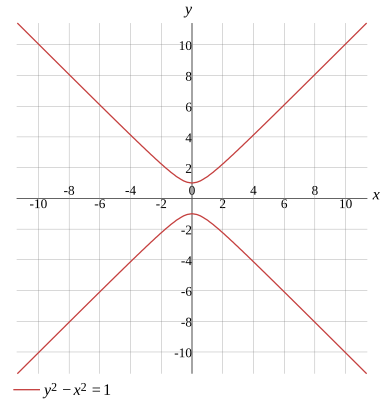Question
Identify the conic
Find the standard equation of the hyperbola
Find the center of the hyperbola
Find the foci of the hyperbola
Load more

y2−x2=1
Evaluate
x2−y2=−1
Multiply both sides of the equation by −1
(x2−y2)(−1)=−(−1)
Multiply the terms
More Steps


Evaluate
(x2−y2)(−1)
Use the the distributive property to expand the expression
x2(−1)−y2(−1)
Multiplying or dividing an odd number of negative terms equals a negative
−x2−y2(−1)
Multiplying or dividing an even number of negative terms equals a positive
−x2+y2
−x2+y2=−(−1)
When there is - in front of an expression in parentheses change the sign of each term of the expression and remove the parentheses
−x2+y2=1
Solution
y2−x2=1
Show Solution

Solve the equation
Solve for x
Solve for y
x=−1+y2x=−−1+y2
Evaluate
x2−y2=−1
Move the expression to the right-hand side and change its sign
x2=−1+y2
Take the root of both sides of the equation and remember to use both positive and negative roots
x=±−1+y2
Solution
x=−1+y2x=−−1+y2
Show Solution

Testing for symmetry
Testing for symmetry about the origin
Testing for symmetry about the x-axis
Testing for symmetry about the y-axis
Symmetry with respect to the origin
Evaluate
x2−y2=−1
To test if the graph of x2−y2=−1 is symmetry with respect to the origin,substitute -x for x and -y for y
(−x)2−(−y)2=−1
Evaluate
More Steps


Evaluate
(−x)2−(−y)2
Rewrite the expression
x2−(−y)2
Rewrite the expression
x2−y2
x2−y2=−1
Solution
Symmetry with respect to the origin
Show Solution

Find the first derivative
Find the derivative with respect to x
Find the derivative with respect to y
dxdy=yx
Calculate
x2−y2=−1
Take the derivative of both sides
dxd(x2−y2)=dxd(−1)
Calculate the derivative
More Steps


Evaluate
dxd(x2−y2)
Use differentiation rules
dxd(x2)+dxd(−y2)
Use dxdxn=nxn−1 to find derivative
2x+dxd(−y2)
Evaluate the derivative
More Steps


Evaluate
dxd(−y2)
Use differentiation rules
dyd(−y2)×dxdy
Evaluate the derivative
−2ydxdy
2x−2ydxdy
2x−2ydxdy=dxd(−1)
Calculate the derivative
2x−2ydxdy=0
Move the expression to the right-hand side and change its sign
−2ydxdy=0−2x
Removing 0 doesn't change the value,so remove it from the expression
−2ydxdy=−2x
Divide both sides
−2y−2ydxdy=−2y−2x
Divide the numbers
dxdy=−2y−2x
Solution
dxdy=yx
Show Solution

Find the second derivative
Find the second derivative with respect to x
Find the second derivative with respect to y
dx2d2y=y3y2−x2
Calculate
x2−y2=−1
Take the derivative of both sides
dxd(x2−y2)=dxd(−1)
Calculate the derivative
More Steps


Evaluate
dxd(x2−y2)
Use differentiation rules
dxd(x2)+dxd(−y2)
Use dxdxn=nxn−1 to find derivative
2x+dxd(−y2)
Evaluate the derivative
More Steps


Evaluate
dxd(−y2)
Use differentiation rules
dyd(−y2)×dxdy
Evaluate the derivative
−2ydxdy
2x−2ydxdy
2x−2ydxdy=dxd(−1)
Calculate the derivative
2x−2ydxdy=0
Move the expression to the right-hand side and change its sign
−2ydxdy=0−2x
Removing 0 doesn't change the value,so remove it from the expression
−2ydxdy=−2x
Divide both sides
−2y−2ydxdy=−2y−2x
Divide the numbers
dxdy=−2y−2x
Divide the numbers
dxdy=yx
Take the derivative of both sides
dxd(dxdy)=dxd(yx)
Calculate the derivative
dx2d2y=dxd(yx)
Use differentiation rules
dx2d2y=y2dxd(x)×y−x×dxd(y)
Use dxdxn=nxn−1 to find derivative
dx2d2y=y21×y−x×dxd(y)
Calculate the derivative
More Steps


Evaluate
dxd(y)
Use differentiation rules
dyd(y)×dxdy
Use dxdxn=nxn−1 to find derivative
dxdy
dx2d2y=y21×y−xdxdy
Any expression multiplied by 1 remains the same
dx2d2y=y2y−xdxdy
Use equation dxdy=yx to substitute
dx2d2y=y2y−x×yx
Solution
More Steps


Calculate
y2y−x×yx
Multiply the terms
More Steps


Multiply the terms
x×yx
Multiply the terms
yx×x
Multiply the terms
yx2
y2y−yx2
Subtract the terms
More Steps


Simplify
y−yx2
Reduce fractions to a common denominator
yy×y−yx2
Write all numerators above the common denominator
yy×y−x2
Multiply the terms
yy2−x2
y2yy2−x2
Multiply by the reciprocal
yy2−x2×y21
Multiply the terms
y×y2y2−x2
Multiply the terms
More Steps


Evaluate
y×y2
Use the product rule an×am=an+m to simplify the expression
y1+2
Add the numbers
y3
y3y2−x2
dx2d2y=y3y2−x2
Show Solution

Rewrite the equation
r=−sec(2θ)r=−−sec(2θ)
Evaluate
x2−y2=−1
To convert the equation to polar coordinates,substitute x for rcos(θ) and y for rsin(θ)
(cos(θ)×r)2−(sin(θ)×r)2=−1
Factor the expression
(cos2(θ)−sin2(θ))r2=−1
Simplify the expression
(2cos2(θ)−1)r2=−1
Divide the terms
r2=−2cos2(θ)−11
Simplify the expression
r2=−sec(2θ)
Evaluate the power
r=±−sec(2θ)
Solution
r=−sec(2θ)r=−−sec(2θ)
Show Solution

Graph
